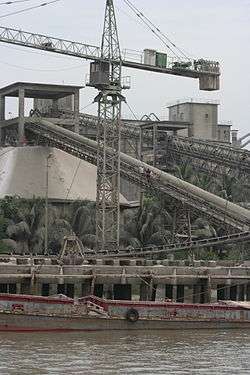Port of Mongla
| Mongla মংলা বন্দর | |
|---|---|
|
Port of Mongla | |
 Mongla Location in Bangladesh | |
| Coordinates: 22°29′20″N 89°35′43″E / 22.48889°N 89.59528°ECoordinates: 22°29′20″N 89°35′43″E / 22.48889°N 89.59528°E | |
| Country |
|
| Division | Khulna Division |
| District | Bagerhat District |
| Time zone | BST (UTC+6) |
Mongla is the main sea port in the Bagerhat District of south-western Bangladesh.
History
The name Mongla originated from Mongla River presently known as Mongla Nulla. Mongla River originated from Pussur and Rampal is situated beside Pussur.[1] The anchorage was shifted to Mongla in 1954 as the place could accommodate sea-going vessels with greater draughts.[2] During the Pakistan period, the administration of the port was under a port director, whose main office was at Khulna.[2]
Geography
It was formerly located at Chalna, about 11 miles (18 km) upstream on the Pusur River, but it is now located 48 km south of Khulna city, as established on 11 December 1954. The Port is surrounded as well as well protected by the Sundarban mangrove forest.[3] The port is situated at the confluence of the Pashur River and the Mongla River. It lies about 62 miles (100 km) north of the Bay of Bengal and is connected to the major inland river ports and to the rail terminal at Khulna.
Trade
Kolkata (formerly Calcutta) and Haldia in India and Mongla and Chittagong in Bangladesh are the principal seaports on the world's largest Ganges delta. The port has trade links with almost all major ports of the world, although vessels arriving here are mostly from ports of Asia, the Middle East, Australia, Europe and North America and the ships rarely come to Mongla from the countries of Latin America or Africa.[2]
The port is open for 24 hours and up to 225 metre long ships can enter into the port for discharging cargo.[3] A constraint free large channel is available for anchorage and loading/unloading facilities on both sides for 33 ships at a time.[3] The port's chief exports include jute, leather, tobacco, frozen fish, and shrimp; major imports include grain, cement, fertilizer, coal, and wood pulp. Its population as of 2001 was 56,746.
